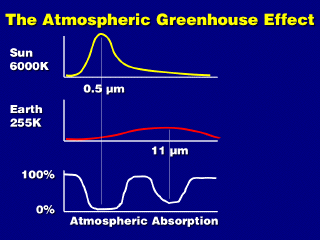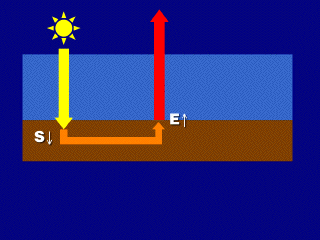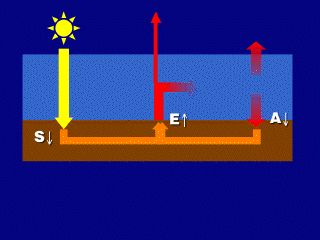 Blackbodies emit most of their radiation
at shorter wavelengths when they get hotter. The sun is much hotter than the
Earth, and given that they are near-blackbodies, the sun will emit most of its
radiation at short wavelengths (visible light) while the Earth emits most of
its radiation in longer wavelengths (IR).
Blackbodies emit most of their radiation
at shorter wavelengths when they get hotter. The sun is much hotter than the
Earth, and given that they are near-blackbodies, the sun will emit most of its
radiation at short wavelengths (visible light) while the Earth emits most of
its radiation in longer wavelengths (IR).
The atmosphere, however, is not a
blackbody. The absorption spectrum in the bottom diagram (% of radiation absorbed)
shows holes, whereas a blackbody should have 100% absorption all the way across.
Note that the holes, where most of the radiation is transmitted, occurs in the
visible spectrum (good for us, because it lets the sunlight through to the ground)
and around the peak of the Earth IR (also good, because if it was all absorbed,
the atmosphere and Earth might get too hot, as it has on Venus). This second
hole in the absorption spectrum, in the IR region, is called the Atmospheric
Window, given that windows transmit radiation. A considerable amount of
IR in the wavelengths just outside this window is still being absorbed by the
atmosphere, so the atmosphere is going to be warmed.



The atmospheric greenhouse effect
is going to depend on the fact that the sun and Earth are blackbodies, and the
atmosphere is transparent to visible light but partially opaque to IR. When
the atmosphere absorbs IR, it must also radiate it to be in radiative
equilibrium. The IR the atmosphere radiates toward the Earth is absorbed
by the blackbody Earth, along with the sunlight that got transmitted through
the atmosphere. The Earth is now receiving more energy than it would if there
were not atmosphere (it would just be the sunlight in that case), so it must
radiate more to compensate, if it is to remain in radiative equilibrium. The
higher the amount of radiation emitted, the higher the temperature of the object.
This effective warming of the lower atmosphere by the "recirculation"
of energy in the form of IR radiation is the greenhouse effect.
See a Shockwave
movie of the greenhouse effect



 Blackbodies emit most of their radiation
at shorter wavelengths when they get hotter. The sun is much hotter than the
Earth, and given that they are near-blackbodies, the sun will emit most of its
radiation at short wavelengths (visible light) while the Earth emits most of
its radiation in longer wavelengths (IR).
Blackbodies emit most of their radiation
at shorter wavelengths when they get hotter. The sun is much hotter than the
Earth, and given that they are near-blackbodies, the sun will emit most of its
radiation at short wavelengths (visible light) while the Earth emits most of
its radiation in longer wavelengths (IR).

